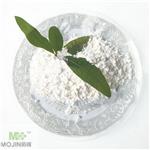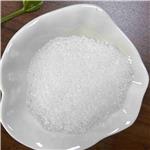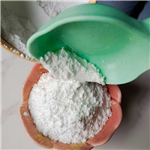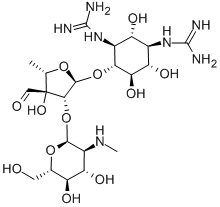- Streptomycin
-

- $0.00 / 25KG
-
2023-08-31
- CAS:57-92-1
- Min. Order: 1KG
- Purity: 99%
- Supply Ability: 50000KG/month
- Streptomycin
-

- $100.00 / 1bag
-
2023-08-31
- CAS:57-92-1
- Min. Order: 1bag
- Purity: 99
- Supply Ability: 5000
- Streptomycin
-

- $20.00 / 1KG
-
2023-03-27
- CAS:57-92-1
- Min. Order: 1KG
- Purity: 99.9%
- Supply Ability: 500MT/month
Related articles - Mechanism of action of Streptomycin
- Streptomycin was the first antibiotic to be effective against tuberculosis and was the first drug of any kind to be tested in ....
- Mar 28,2022
|
| | Streptomycin Basic information |
| Product Name: | Streptomycin | | Synonyms: | O-2-deoxy-2-(methylamino)-a-L-glucopyranosyl-(1-2)-O-5-deoxy-3-C-formyl-a-L-lyxofura nosyl-(1-4)-N1,N3-bis(aminoiminomethyl)-D-streptamine;N,N'''-[(1S,2S,3S,4R,5S,6R)-4-({5-Deoxy-2-O-[2-deoxy-2-(methylamino)-alpha-D-mannopyranosyl]-3-C-formyl-beta-D-ribofuranosyl}oxy)-2,5,6-trihydroxycyclohexane-1,3-diyl]diguanidine;4-O-[2-O-[2-(Methylamino)-2-deoxy-α-L-glucopyranosyl]-3-C-formyl-5-deoxy-α-L-lyxofuranosyl]-N,N'-bis[amino(imino)methyl]-D-streptamine;4-O-[2-O-[2-Deoxy-2-(methylamino)-α-L-glucopyranosyl]-5-deoxy-3-formyl-α-L-lyxofuranosyl]-N,N'-bis(aminoiminomethyl)-D-streptamine;Streptomycin (base and/or unspecified derivatives);O-2-deoxy-2-(methylamino)-α-L-glucopyranosyl-(1-2)-O-5-deoxy-3-C-formyl-α-L-lyxofura nosyl-(1-4)-N1,N3-bis(aminoiminomethyl)-D-streptamine;STREPTOMYCIN;Streptomycin (Inj.) | | CAS: | 57-92-1 | | MF: | C21H39N7O12 | | MW: | 581.57 | | EINECS: | 200-355-3 | | Product Categories: | Intermediates & Fine Chemicals;Oligosaccharides;Pharmaceuticals;Oligosaccharide Compounds | | Mol File: | 57-92-1.mol |  |
| | Streptomycin Chemical Properties |
| Melting point | 194 °C | | Boiling point | 639.94°C (rough estimate) | | density | 1.4142 (rough estimate) | | refractive index | 1.6800 (estimate) | | storage temp. | 2-8°C | | pka | pKa 7.84(H2O
t = 25
I = 0.1) (Uncertain);11.54(H2O
t = 25
I = 0.1) (Uncertain);>12(H2O
t = 25
I = 0.1) (Uncertain) | | EPA Substance Registry System | Streptomycin (57-92-1) |
| | Streptomycin Usage And Synthesis |
| Description | The antibiotic streptomycin is an important and effective
chemical for the management of bacterial diseases of
fruit trees (especially apple), woody ornamentals, and
vegetables. Streptomycin was initially discovered in 1944
and was one of the first antibiotics to be utilized in
clinical medicine to control human diseases, and is still
important as a feed amendment for growth promotion
in agricultural animals. The widespread and diverse
usage of streptomycin has contributed to the currently
observed global streptomycin resistance (SmR) problem.
This problem is especially critical in plant disease
management, as there are few alternatives to streptomycin
available and, as a consequence of increased usage, SmR
has been increasingly observed among bacterial plant
pathogens. | | Chemical Properties | Crystalline Powder | | Originator | Streptomycin,MSD,US,1945 | | History | Streptomycin is discovered in 1944 of streptomycin drew immediate interest because it was the least toxic of the broad-spectrum antibiotics known at that time. Indeed, streptomycin was used to treat many gram-negative microbial infections, but because of the ease with which organisms developed resistance to it during treatment, many of these applications were abandoned when the tetracyclines, discussed later, became available. Streptomycin was the first parenterally administered antibiotic active against many microorganisms, but during the last several years, its use has been limited essentially to three situations: (1) the initial treatment of serious tuberculous infections, when the principal drugs of choice (isoniazid, rifampin) cannot be used because of their adverse effects on a particular patient; (2) treatment of enterococcal and other infections, in which synergism between a penicillin and an aminoglycoside is desired; and (3) treatment of certain uncommon infections (plague and tularemia). | | Uses | Antibiotic substance produced by aerobic fermentation. Antibacterial (tuberculostatic). | | Uses | Control of bacterial shot-hole, bacterial rots, bacterial
canker, bacterial wilts, fire blight, and other diseases
caused by gram-positive species of bacteria in pome
fruit, stone fruit, citrus fruit, olives, vegetables, potatoes,
tobacco, cotton, and ornamentals. Chlorosis may occur on
grapes, pears, peaches, and some ornamentals. Formulation
types WP; Liquid. Incompatible with pyrethrins
and alkaline materials. A mixture of streptomycin and
oxytetracycline is highly effective for the control of bacterial
canker of peach, citrus canker, soft rot of vegetables,
and various other bacterial diseases. Selected tradenames
“Agrimycin 17” (sesquisulfate); “AS-50” (sesquisulfate). | | Uses | Streptomycin is the most commonly utilized bactericidal
antibiotic for the management of plant pathogens
and has been used most frequently on apple, pear, sweet
pepper, and ornamental trees. | | Definition | ChEBI: A amino cyclitol glycoside that consists of streptidine having a disaccharyl moiety attached at the 4-position. The parent of the streptomycin class | | Indications | Streptomycin, an aminoglycoside antibiotic was the first drug shown to reduce tuberculosis
mortality. Streptomycin is bactericidal against M. tuberculosis
in vitro but is inactive against intracellular
organisms. Most M. tuberculosis strains and nontuberculosis
species, such as M. kansasii and M. aviumintracellulare,
are sensitive. Spontaneous resistance to
streptomycin, seen in approximately 1 in 106 tubercle
bacilli, is related to a point mutation that involves the
gene (rpsl or rrs) that encodes for ribosomal proteins
and binding sites.About 80% of strains that are resistant
to isoniazid and rifampin are also resistant to streptomycin. | | Manufacturing Process | A medium is prepared having the following composition in tap water: 1.0%
glucose; 0.5% peptone; 0.3% meat extract; and 0.5% NaCl. This medium is
distributed in appropriate vessels to a depth of 1 to 2 inches, sterilized at 10
pounds steam pressure for 45 to 50 minutes, and then cooled.
The medium in each vessel is then inoculated with a heavy aqueous
suspension of spores of a strain of Actinomyces griseus, and the inoculated
media are maintained at an incubation temperature of 22° to 28°C for 10
days. The growth is then filtered off and the filtrates are combined for further
treatment.
To a batch of approximately 10 liters of filtered broth is added 150 grams of
activated charcoal. The mixture is stirred continuously for about 5 minutes
and is then filtered. The slightly yellowish (almost colorless) filtrate is
discarded and the charcoal residue is washed several times with distilled water
and finally with 95% ethanol. The washed material is then suspended in 1.5
liters of 95% ethanol, made 0.15 normal with hydrochloric acid. The
suspension is stirred for about an hour and allowed to stand in the cold for
about 10 hours more with occasional stirring. The suspension is then filtered,
the charcoal residue discarded, and the yellowish clear filtrate thus obtained is
poured into 10 liters of ether, with stirring. A brown-colored aqueous layer
separates and is drawn off.
The alcohol-ether solution is washed with 100 cc of water and the brown
aqueous layer is drawn off and added to the first aqueous layer. The aqueous
solution is neutralized to pH 6 to 7 with dilute sodium hydroxide and any
precipitate that forms is filtered off and discarded. A faintly colored aqueous
solution containing streptomycin is thus obtained. | | Brand name | Antidiarrhoicum;Bio hubber fuerte;Bio hubbersimple;Cidan est;Darostrep;Derbitan antibiotico;Diastat;Direver;Estrepromade;Estrepromicina;Estrepto e;Estrepto level;Estrepto ph;Estrepto wolner;Estreptomicina normon;Gamafin;Injectin;Neodistreptotab;Neodualtrepto;Novostrep;Novo-strep;Servistrep;Solustrep;Solvo-strep-s;Solvo-strept-s;Strep-diva;Strepolin;Streptan;Streptaquaine;Streptocal;Strepto-fatal;Streptosol 25;Streptothenat;Stretobretin;Sul-mycin ii. | | Therapeutic Function | Antitubercular | | World Health Organization (WHO) | Oral preparations of streptomycin, an aminoglycoside antibiotic
isolated from streptomyces griseus in 1944, were formerly widely used to treat
intestinal infections. There is no evidence that streptomycin is effective in this
indication and its widespread use promotes the emergence of resistant strains of
bacteria. The World Health Organization recommends that streptomycin should not
be used for the treatment of diarrhoea.
(Reference: (WHORUD) The Rational Use of Drugs, , , 1990) | | Antimicrobial activity | It is less active than gentamicin group compounds
against most micro-organisms within the spectrum,but it is particularly active against mycobacteria, including
M. kansasii and most strains of M. ulcerans. Brucella (MIC
0.5 mg/L), Francisella, Pasteurella spp. and Yersinia pestis are
susceptible.
It is actively bactericidal, the speed of killing increasing
progressively with concentration. The antibacterial activity
is greatest in a slightly alkaline medium (pH 7.8) and is
considerably reduced below pH 6.0. It is so sensitive to the
effect of pH that the natural acidity of a solution of streptomycin
sulfate may be sufficient to depress its antibacterial
activity. | | Acquired resistance | In contrast to most other aminoglycosides, high level resistance
can result from a single-step mutation in the gene
encoding ribosomal protein S12 (rpsL), which alters the protein
so that binding is reduced. Resistance in some clinical
isolates of M. tuberculosis is associated either with missense
mutations in the rpsL gene, or with base substitutions at position
904 in the 16S rRNA.
Resistance can also be caused by aminoglycosidemodifying
enzymes: phosphotransferases that modify the
3″-hydroxyl group in both Gram-negative and Grampositive
organisms; a phosphotransferase that modifies the
6-hydroxyl group in Pseudomonas spp.; and a nucleotidyltransferase
that modifies the 3″-hydroxyl group in Gramnegative
organisms.
Increase in resistance often occurs within a few days (for
M. tuberculosis a few weeks) of the beginning of treatment, and
resistance of many species is now common. Primary streptomycin
resistance in M. tuberculosis is much more common in
the Far East and less developed countries than in the UK and
USA. However, several clusters of multidrug-resistant
tuberculosis
have been identified among hospital patients with
AIDS in the USA.
Strains of streptococci and enterococci showing moderate
resistance (MIC 6–500 mg/L) exhibit synergy with penicillin,
but strains showing high levels of resistance (MIC
>500 mg/L) have ribosomes that are resistant to streptomycin
and simultaneous treatment with penicillin is without
effect.
It is not uncommon to find strains of bacteria, including
M. tuberculosis, that are actually favored by the presence
of the antibiotic or completely dependent on it. Isolated
ribosomes from streptomycin-dependent Esch. coli show a
change in the same single ribosomal protein that determines
resistance and synthesize peptides only in the presence of
the drug.
Streptomycin-resistant bacteria usually remain sensitive to
other aminoglycosides. Enterococci with high-level resistance
to gentamicin, and consequent resistance to gentamicin–β-
lactam synergy, may show synergy between the β-lactam and
streptomycin. | | Hazard | Damage to nerves and kidneys may result
from ingestion. Use restricted by FDA. | | Mechanism of action | The mechanism of action of STM and the aminoglycosides in general has not been fully elucidated. It is known that the STM inhibits protein synthesis, but additional effects on misreading of an mRNA template and membrane damage may contribute to the bactericidal action of ST M. Streptomycin is able to diffuse across the outer membrane of Mycobacterium tuberculosis and, ultimately, to penetrate the cytoplasmic membrane through an electron�dependent process. Through studies regarding the mechanism of drug resistance, it has been proposed that STM induces a misreading of the genetic code and, thus, inhibits translational initiation. In ST M-resistant organisms, two changes have been discovered: First, S12 protein undergoes a change in which the lysine present at amino acids 43 and 88 in ribosomal protein S12 is replaced with arginine or threonine, and second, the pseudoknot conformation of 16S rRNA, which results from intramolecular base pairing between GCC bases in regions 524 to 526 of the rRNA to CGG bases in regions 505 to 507, is perturbed. It is thought that S12 protein stabilizes the pseudoknot, which is essential for 16S rRNA function. By some yet-to-be-defined mechanism, STM interferes with one or both of the normal actions of the 16S protein and 16S rRNA. | | Pharmacology | Ototoxicity and nephrotoxicity are the major concerns
during administration of streptomycin and other
aminoglycosides. The toxic effects are dose related and
increase with age and underlying renal insufficiency.All
aminoglycosides require dose adjustment in renal failure
patients. Ototoxicity is severe when aminoglycosides
are combined with other potentially ototoxic
agents. | | Clinical Use | Streptomycin is indicated as a fourth drug in combination
with isoniazid, rifampin, and pyrazinamide in patients
at high risk for drug resistance. It is also used in
the treatment of streptomycin-susceptible MDR tuberculosis. | | Clinical Use | Tuberculosis (in combination with other antituberculosis drugs)
Infections caused by M. kansasii (in combination with other
antimycobacterial agents)
Plague and tularemia, including tularemia pneumonia
Bacterial endocarditis (in combination with a penicillin)
Brucellosis
Whipple’s disease (in combination with other antibiotics)
The most important use of streptomycin is in the treatment of
tuberculosis . Depression of vestibular function by
streptomycin has been used in the treatment of patients suffering
from Ménière’s disease. | | Side effects | Pain and irritation at the site of injection are common,
and sterile inflammatory reactions or peripheral neuritis
from direct involvement of a nerve sometimes occur. Many
patients experience circumoral paresthesia, vertigo and
ataxia, headaches, lassitude and ‘muzziness in the head’.
Renal dysfunction is rare but has been described in patients
receiving 3–4 g per day.
Ototoxicity
The most common serious toxic effect is vestibular disturbance,
which is related to total dosage and excessive
blood concentrations, and hence to the age of the patient
and the state of renal function. In older patients the risk of
damage is higher and compensation is less than in young
patients. Persistence of the drug in the perilymph after
the plasma concentration has fallen may play an important
part in such ototoxicity. There is no significant relation
between incidence of dizziness and peak streptomycin
concentration, but a highly significant relation to plasma
concentrations exceeding 5 mg/L at 24 h. The risk to hearing
is much less, but damage sometimes occurs after only
a few doses. Congenital hearing loss or abnormalities in
the caloric test or audiogram have been described several
times in children born to women treated with streptomycin
in pregnancy. There is considerable individual variation
in susceptibility to its toxic effects, which may be
partly genetically determined.
Allergy
In addition to eosinophilia unassociated with other allergic
manifestations, rashes and drug fever occur in about 5% of
treated patients. These are usually trivial and respond to antihistamine
treatment, so that in most cases therapy can be
continued, although this should be done with caution, since
occasionally severe and even fatal exfoliative dermatitis may
develop. Skin sensitization is also common in nurses and dispensers
who handle streptomycin and may lead to severe dermatitis,
sometimes associated with periorbital swelling and
conjunctivitis. Reactions most frequently develop between
4 and 6 weeks, but may appear after the first dose or after
6 months’ treatment. Patients who develop hypersensitivity
during prolonged therapy can generally be desensitized
by giving 20 mg prednisolone daily plus 10 daily increments
from 0.1 to 1.0 g streptomycin when normal dosage will usually
be tolerated, or by giving increased doses of streptomycin
every 6 h.
Neuromuscular blockade
It is rare for neuromuscular blockade to develop in those
whose neuromuscular mechanisms are normal, but patients
who are also receiving muscle relaxants or anesthetics, or are
suffering from myasthenia gravis are at special risk.
Other effects
Rare neurological manifestations include peripheral neuritis
and optic neuritis with scotoma. Other rare effects have been
aplastic anemia, agranulocytosis, hemolytic anemia, thrombocytopenia,
hypocalcemia and severe bleeding associated
with a circulating factor V antagonist. | | Safety Profile | Poison by intravenous and subcutaneous routes. Moderately toxic by ingestion and intraperitoneal routes. An experimental teratogen. Human systemic effects by ingestion and intraperitoneal routes: change in vestibular functions, blood pressure decrease, eosinophilia, respiratory depression, and pulmonary changes. Human reproductive and teratogenic effects by unspecified routes: developmental abnormalities of the eye and ear and effects on newborn including postnatal measures or effects. Toxic to hdneys and central nervous system. Has been implicated in aplastic anemia. Experimental reproductive effects. Human mutation data reported. When heated to decomposition it emits toxic fumes of NOX. | | Synthesis | Streptomycin, trans-2,4-diguanidino-3,5,6-trihydroxycyclohexyl-5-deoxy-2-
O-(2-deoxy-2-methylamino-α-L-glucopyranosyl)-3-C-hydroxymethyl-β-L-lyxo-pentofura�noside (32.4.1), is isolated from a culture liquid of the vital activity of the actinomycete S.
griseus. | | Drug interactions | Potentially hazardous interactions with other drugs
Antibacterials: increased risk of nephrotoxicity
with colistimethate or polymyxins and possibly
cephalosporins; increased risk of ototoxicity and
nephrotoxicity with capreomycin or vancomycin.
Ciclosporin: increased risk of nephrotoxicity.
Cytotoxics: increased risk of nephrotoxicity and
ototoxicity with platinum compounds.
Loop diuretics: increased risk of ototoxicity.
Muscle relaxants: enhanced effects of non�depolarising muscle relaxants and suxamethonium.
Parasympathomimetics: neostigmine and
pyridostigmine antagonised by aminoglycosides.
Tacrolimus: increased risk of nephrotoxicity. | | Environmental Fate | The mechanism of toxicity for aminoglycosides has not been
fully explained and is therefore unclear. It is known that the
drug attaches to a bacterial cell wall and is drawn into the cell
via channels made up of a protein, porin. Once inside the cell,
aminoglycoside attaches to the 30S bacterial ribosomes.
Ribosomes are the intracellular structures responsible for
manufacturing proteins. This attachment either inhibits protein
biosynthesis or causes the cell to produce abnormal, ineffective
proteins. The bacterial cell cannot survive with this impediment.
This explanation, however, does not account for the
potent bactericidal properties of these agents, since other
antibiotics that inhibit the synthesis of proteins (such as
tetracycline) are not bactericidal. Recent experimental studies
show that the initial site of action is the outer bacterial
membrane. The cationic antibiotic molecules create fissures in
the outer cell membrane, resulting in leakage of intracellular
contents and enhanced antibiotic uptake. This rapid action at
the outer membrane probably accounts for most of the bactericidal
activity.
Energy is needed for aminoglycoside uptake into the
bacterial cell. Anaerobes have less energy available for this
uptake, so aminoglycosides are less active against anaerobic
bacteria (bacteria that cannot grow in the presence of oxygen),
viruses, and fungi. And only one aminoglycoside, paromomycin,
is used against parasitic infection. Like all other antibiotics,
aminoglycosides are not effective against influenza, the
common cold, or other viral infections. | | Metabolism | Streptomycin inhibits protein synthesis in bacterial cells
by binding to the 30S ribosomal subunit and causes misreading
of the genetic codes in protein synthesis (29).
Streptomycin-resistant strains are distributed in a wide
range of plant pathogenic bacteria, such as Xanthomonas
oryzae, X. citri, Pseudomonas tabaci, and P. lachrymans.
In agricultural use, the alternative or combined applications
of streptomycin and other chemicals with different
action mechanisms is recommended in order to reduce the
development of streptomycin-resistant strains in the field.
Mutants of E. coli highly resistant to streptomycin are
known to involve modification of the P10 protein of the
bacterial ribosome 30S subunit. | | Toxicity evaluation | Streptomycin: Acute oral LD50 for mice >10 g/kg.
Acute percutaneous LD50 for male mice 400, female
mice 325 mg/kg. May cause allergic skin reaction. NOEL:
125 mg/kg. Acute i.p. LD50 for male mice 340, female mice
305 mg/kg. Streptomycin sesquisulfate: Acute oral LD50
for rats 9, mice 9, hamsters 0.4 mg/kg. |
| | Streptomycin Preparation Products And Raw materials |
|